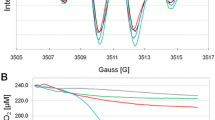Abstract
Exposure of amino acids, peptides and proteins to radicals in the presence of O2generates hydroperoxides in a dose-dependent manner. These hydroperoxides are stable in the absence of exogenous catalysts (e.g. heat, light, redox-active transition metal ions), but decompose rapidly in the presence of these agents to give a variety of radicals including alkoxyl (RO•), peroxyl (ROO•) and carbon-centred (R•) species. These radicals are shown to react with DNA to give DNA-protein cross-links and single strand breaks.
Similar content being viewed by others
References
Aruoma OI and Halliwell B (1998) Molecular Biology of Free Radicals in Human Diseases. OICA International, London
Bohlen P, Stein S, Dairman W and Udenfriend S (1973) Fluorometric assay of proteins in the nanogram range. Arch Biochem Biophys 155: 213-220
Davies MJ (1996) Protein and peptide alkoxyl radicals can give rise to C-terminal decarboxylation and backbone cleavage. Arch Biochem Biophys 336: 163-172
Davies MJ and Dean RT (1997) Radical Mediated Protein Oxidation: From Chemistry to Medicine. Oxford University Press, Oxford
Davies MJ, Fu S and Dean RT (1995) Protein hydroperoxides can give rise to reactive free radicals. Biochem J 305: 643-649
Davies MJ, Fu S, Wang H and Dean RT (1999) Stable markers of oxidant damage to proteins and their application in the study of human disease. Free Radic Biol Med 27: 1151-1163
Dean RT, Fu S, Stocker R and Davies MJ (1997) Biochemistry and pathology of radical-mediated protein oxidation. Biochem J 324: 1-18
Dizdaroglu M (1984) The use of capillary gas-chromatography mass-spectroscopy for identification of radiation-induced base damage and DNA-base amino-acid cross-links. J Chromat 295: 103-121
Dizdaroglu M and Gajewski E (1989) Structure and mechanism of hydroxyl radical-induced formation of a DNA-protein cross-link involving thymine and lysine in nucleohistone. Cancer Res 49: 3463-3467
Dizdaroglu M, Gajewski E, Reddy P and Margolis SA (1989) Structure of a hydroxyl radical induced DNA-protein cross-link involving thymine and tyrosine in nucleohistone. Biochemistry 28: 3625-3628
Farahani M and Simic MG (1988) Hydroxyl radical induced crosslinking between phenylalanine and 2-deoxyribose. Biochemistry 27: 4695-4698
Fu S, Gebicki S, Jessup W, Gebicki JM and Dean RT (1995) Biological fate of amino acid, peptide and protein hydroperoxides. Biochem J 311: 821-827
Gajewski E and Dizdaroglu M (1990) Hydroxyl radical induced cross-linking of cytosine and tyrosine in nucleohistone. Biochemistry 29: 977-980
Gay C, Collins J and Gebicki JM (1999) Hydroperoxide assay with the ferric-xylenol orange complex. Anal Biochem 273: 149-155
Gebicki JM (1997) Protein hydroperoxides as new reactive oxygen species. Redox Rep 3: 99-110
Gebicki S and Gebicki JM (1993) Formation of peroxides in amino acids and proteins exposed to oxygen free radicals. Biochem J 289: 743-749
Gebicki S and Gebicki JM(1999) Crosslinking of DNA and proteins induced by protein hydroperoxides. Biochem J 338: 629-636
Gebicki S, Dean RT and Gebicki JM (1996) Inactivation of glutathione reductase by protein and amino acid peroxides In: Oxidative Stress and Redox Regulation: Cellular Signalling, AIDS, Cancer and Other Diseases. 139. Institute Pasteur, Paris
Gilbert BC, Stell JK, Whitwood AC, Halliwell C and Sanderson WR (1991) Mechanisms of peroxide decomposition. An EPR investigation of the reactions between some transition metal ions (TiIII, FeII, CuI) and monoperoxyphthalic acid and its anion. J Chem Soc Perkin Trans 2: 629-634
Greenley TL and Davies MJ (1994) Direct detection of radical generation in rat liver nuclei on treatment with tumour-promoting hydroperoxides and related compounds Biochim Biophys Acta 1226: 56-64
Halliwell B and Gutteridge JMC (1999) Free Radicals in Biology and Medicine, 3rd ed. Oxford University Press, Oxford
Jessup W, Dean RT and Gebicki JM (1994) Iodometric determination of hydroperoxides in lipids and proteins. Meth Enzymol 233: 289-303
Lloyd DR, Phillips DH and Carmichael PL (1997) Generation of putative intrastrand cross-links and strand breaks in DNA by transition metal ion-mediated oxygen radical attack. Chem Res Toxicol 10: 393-400
Luxford C, Dean RT and Davies MJ (2000) Radicals derived from histone hydroperoxides damage nucleobases in RNA and DNA. Chem Res Toxicol 13: 665-672
Luxford C, Morin B, Dean RT and Davies MJ (1999) Histone H1-and other protein-and amino acid-hydroperoxides can give rise to free radicals which oxidise DNA. Biochem J 344: 125-134
Mee LK and Adelstein SJ (1981) Predominance of core histones in formation of DNA-protein crosslinks in ?-irradiated chromatin. Proc Natl Acad Sci USA 78: 2194-2198
Nackerdien Z, Rao G, Cacciuttolo MA, Gajewski E and Dizdaroglu M (1991) Chemical nature of DNA-protein cross-links produced in mammalian chromatin by hydrogen peroxide in the presence of iron and copper ions. Biochemistry 30: 4873-4879
Olinski R, Nackerdien Z and Dizdaroglu M (1992) DNA-protein cross-linking between thymine and tyrosine in chromatin of gamma-irradiated or H2O2-treated cultured cells. Arch Biochem Biophys 297: 139-143
Simpson JA, Narita S, Gieseg S, Gebicki S, Gebicki JM and Dean RT (1992) Long-lived reactive species on free-radical-damaged proteins. Biochem J 282: 621-624
Xue L-Y, Friedman LR, Oleinick NL and Chiu S-M (1994) Induction of DNA damage in ?-irradiated nuclei stripped of nuclear protein classes: differential modulation of double-strand break and DNA-protein crosslink formation. Int J Radiat Biol 66: 11-21
Author information
Authors and Affiliations
Corresponding author
Rights and permissions
About this article
Cite this article
Luxford, C., Dean, R.T. & Davies, M.J. Induction of DNA damage by oxidised amino acids and proteins. Biogerontology 3, 95–102 (2002). https://doi.org/10.1023/A:1015228001561
Issue Date:
DOI: https://doi.org/10.1023/A:1015228001561




